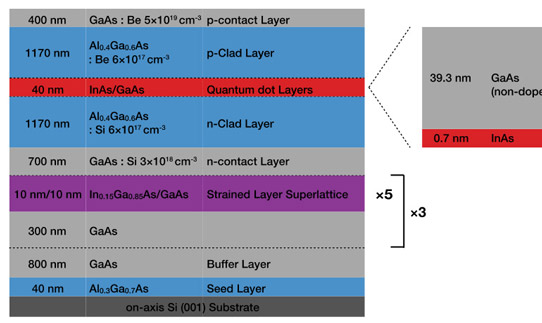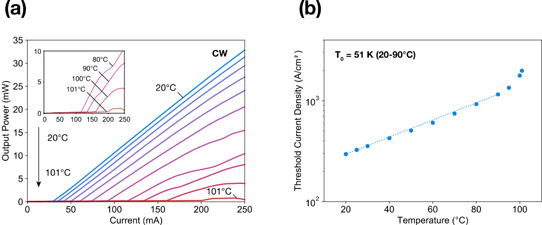- News
14 March 2019
Indium arsenide quantum dot laser diodes on on-axis silicon
Japan’s University of Tokyo has achieved high-temperature continuous-wave laser diode (LD) operation from an active region consisting of indium arsenide (InAs) quantum dots in gallium arsenide (GaAs) grown on on-axis (001) silicon [Jinkwan Kwoen et al, Optics Express, vol27, p2681, 2019].
The laser diode operated at a temperature of 100°C – previous devices on on-axis silicon have only managed performance below this temperature. The use of low-cost on-axis (001) silicon opens up prospects of monolithic integration with silicon photonics and mainstream CMOS electronics. One feature of QD devices is greater tolerance to the presence of dislocations, which tend to have higher density in heterostructures of III-V materials such as InAs and GaAs on silicon.
The researchers used molecular beam epitaxy (MBE) on (001) n-type silicon. The misorientation of the silicon was less than 0.2°. The QD material (Figure 1) consisted of a buffer layer, dislocation filtering by a series of superlattices, and the device layers. The individual QDs extended about 30nm laterally when uncapped. The QD density was about 5x1010/cm2. The threading dislocation density was 4.7x107/cm2. The team believe that the dislocation density could be reduced to less than 107/cm2 by thermal cyclic annealing techniques.

Figure 1: Schematic of epitaxial layers of InAs/GaAs QD laser.
Laser diodes were fabricated with 7μm-wide mesas. The mesa was narrower than the group’s previous work. The resulting improved heat dissipation and current constriction enabled continuous wave (CW) operation up to 101°C.
The p- and n-contacts were both gold-germanium-nickel alloy and then gold. Silicon dioxide insulator coated the mesa sidewalls. The silicon substrate was thinned to 100μm before cleaving the laser diodes into 1.1mm-long devices. The facets were not coated to create high-reflective cavities.
The resulting laser diode had a 27.6mA lasing current threshold (370A/cm2 density, Figure 2). The slope efficiency varied between 53.2W/A at 20°C and 26/3mW/A at 100°C. The characteristic temperature for the shift in threshold current (T0) was 50K up to 90°C.

Figure 2: (a) Temperature dependence of light output power versus current characteristics under CW operation for InAs/GaAs QD laser. (b) Temperature dependence of threshold current density.
Under 210mA current injection, the ground-state wavelengths were 1224.6nm and 1272.0nm at 20°C and 101°C, respectively, representing a 0.62nm/K shift rate.
InAs quantum dots InAs GaAs Silicon photonics MBE
https://doi.org/10.1364/OE.27.002681
The author Mike Cooke is a freelance technology journalist who has worked in the semiconductor and advanced technology sectors since 1997.


